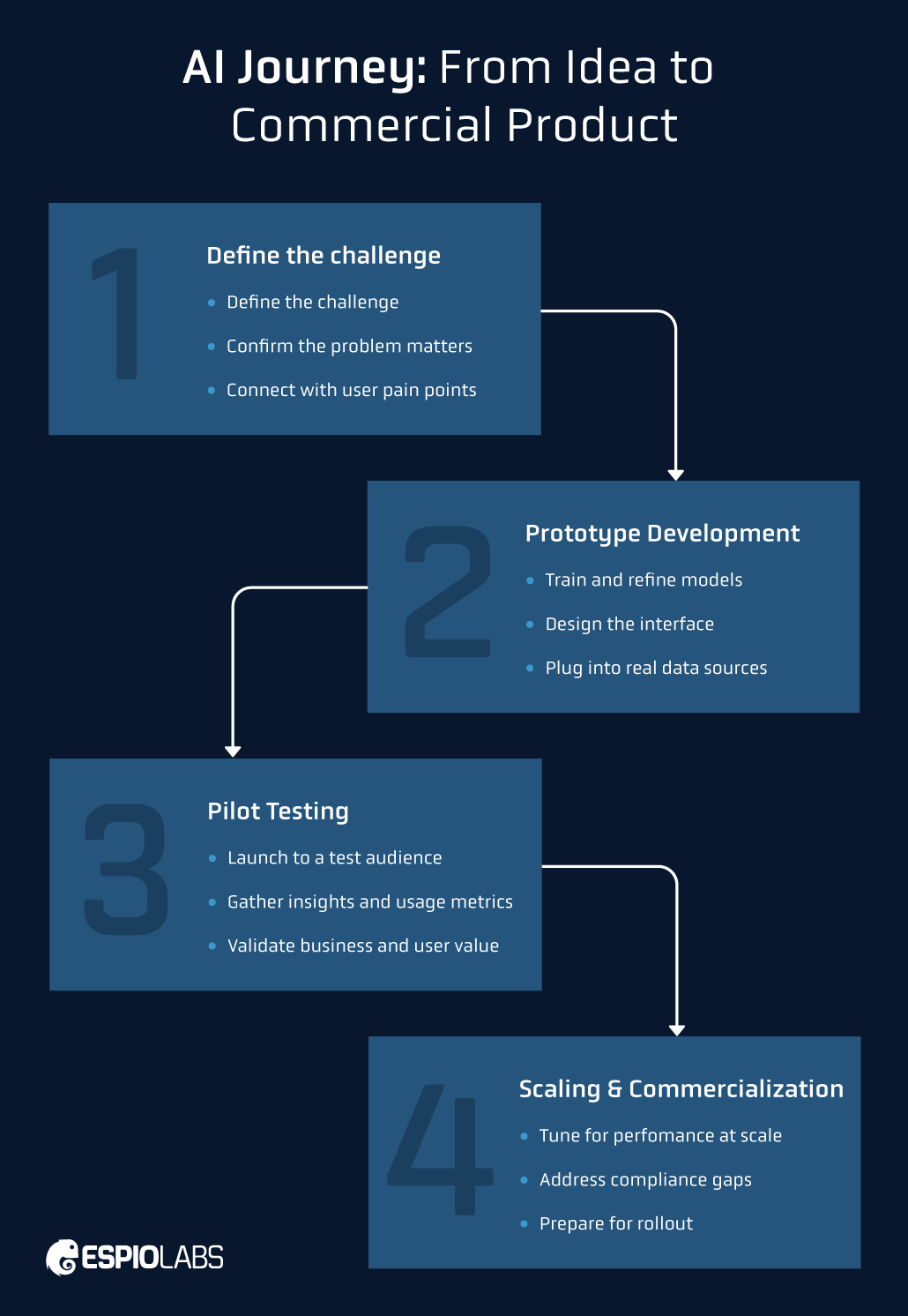AI R&D Labs: Turning Prototypes Into Scalable AI Products
AI R&D Labs are redefining AI product development. These innovation labs give companies a smarter way to prototype, validate, and scale—from early AI MVPs to full enterprise AI deployments.
Innovation doesn’t happen in a vacuum. Businesses that thrive tend to be those that shorten the distance between concept and product. That’s where AI and software R&D labs come in. These labs are purpose-built environments where teams can test new ideas, develop machine learning models, and build prototypes in weeks rather than months. But they aren’t just about speed. They’re structured to reduce risk, validate ideas early, and help businesses make smarter bets on emerging technologies.
Instead of relying on traditional development processes weighed down by red tape, AI R&D labs offer a high-agility environment. They give companies access to powerful computing, relevant datasets, and the frameworks needed to build and test AI software efficiently. The result? More progress. Less waste.
Want to see if an AI R&D lab fits your product vision? Start a AI project consultation with EspioLabs.
How an AI R&D Lab Accelerates AI Product Development
Speed is nothing without direction. R&D labs thrive not just because they build fast, but because they build with purpose. In a well-structured AI lab, teams aren’t just coding, they’re solving real problems with focused experimentation.
Here’s why the model works:
- High-performance computing environments that let teams run intensive models without delay
- Access to cleaned, structured data that’s relevant and ready to use
- Machine learning toolkits like TensorFlow, PyTorch, and Hugging Face
- Cross-functional collaboration spaces where engineers, data scientists, and product leaders work side by side
With these in place, teams can:
- Build and iterate MVPs within weeks
- Stress-test models under real conditions
- Catch security and UX issues before they snowball
This structured environment is the backbone of modern agile AI workflows—allowing teams to go from a machine learning prototype to a market-ready product in weeks, not months.
Imagine a team creating a smart inventory forecasting tool for retail. Without a lab, they’d juggle scattered resources and siloed expertise. With one, they can get a working prototype out the door fast and improve it continuously with expert input.
Curious how fast your team could launch an AI MVP? Explore our custom AI solutions.
Mentorship in AI Labs: The Missing Link in Scalable Product Design
Resources help. But experience guides. And that guidance often makes the difference between a stalled build and a successful launch.
AI R&D labs embed mentorship into the fabric of every project, especially crucial during high-stakes phases of AI pilot testing and data science MVPs, where real-world deployment guidance is key.
. Think of it as strategic coaching rather than vague advice. The feedback is specific, contextual, and grounded in lived expertise.
Examples?
- A cybersecurity lead points out a weak data pipeline before it breaks under load.
- An AI researcher fine-tunes a model that was performing well—just not well enough.
- A UX strategist reframes the product experience to fit actual user workflows.
Mentorship flows through:
- Regular design and code reviews
- Teams-based Q&A support and asynchronous feedback
- Real-time reviews of security, compliance, or accessibility issues
These small but constant interventions help projects avoid the traps that kill momentum: overcomplication, misalignment, or feature creep.
Need expert input on your AI project? Talk to our AI experts in Ottawa today.
AI Development Lifecycle: From MVP to Market-Ready Product
Turning a concept into something a customer can use is harder than it looks. Many teams build a solid proof-of-concept, only to stall when they hit integration or scale. This AI development lifecycle helps teams avoid the prototype graveyard.
Here’s the typical arc:
1. Idea framing
- Clarify the business goal
- Identify who benefits and how
- Validate assumptions with real users
2. MVP development
- Build something testable, not perfect
- Gather feedback quickly and act on it
- Revisit goals based on user behaviour
3. Scale-readiness
- Stress-test infrastructure
- Perform security and compliance checks
- Design for maintainability
4. Commercialisation
- Identify early customers or pilot partners
- Secure investor interest
- Launch with confidence
One public example: Microsoft’s AI Co-Innovation Lab partnered with the BBC to prototype a tool that surfaced math-related educational content. The lab didn’t just build the software. They helped validate the user journey and prepare the tool for real-world deployment.
Read More: Innovative Software & AI R&D Labs: Driving Tomorrow’s Technologies
Visualizing Your AI Journey: From Idea to Commercial Product

It helps to see the process in motion. Here’s a simplified version of how an idea travels through an AI R&D lab:
1. Idea Discovery
- Define the challenge
- Confirm the problem matters
- Connect with user pain points
2. Prototype Development
- Train and refine models
- Design the interface
- Plug into real data sources
3. Pilot Testing
- Launch to a test audience
- Gather insights and usage metrics
- Validate business and user value
4. Scaling and Commercialisation
- Tune for performance at scale
- Address compliance gaps
- Prepare for rollout
Each phase is supported by mentors, technical toolkits, and structured check-ins to keep momentum steady.
Want to visualise your AI product roadmap? Book a working session with our team
Ready to make real progress on your AI initiative?
AI R&D labs aren’t a luxury—they’re a smart strategy for any team investing in AI innovation labs, scalable AI product design, and repeatable AI commercialization processes. By combining infrastructure, mentorship, iterative testing, and business alignment, they help teams ship smarter, faster, and with fewer setbacks.
If you’re tired of idea graveyards and stalled prototypes, maybe it’s time to work differently.
Let’s start building. Contact us today.
Read More:
How AI is Revolutionizing Cybersecurity Threat Detection
The Future of AI- Powered Software and Application Development
Edge AI vs Cloud AI: Best AI Architecture for Business Use in 2025
